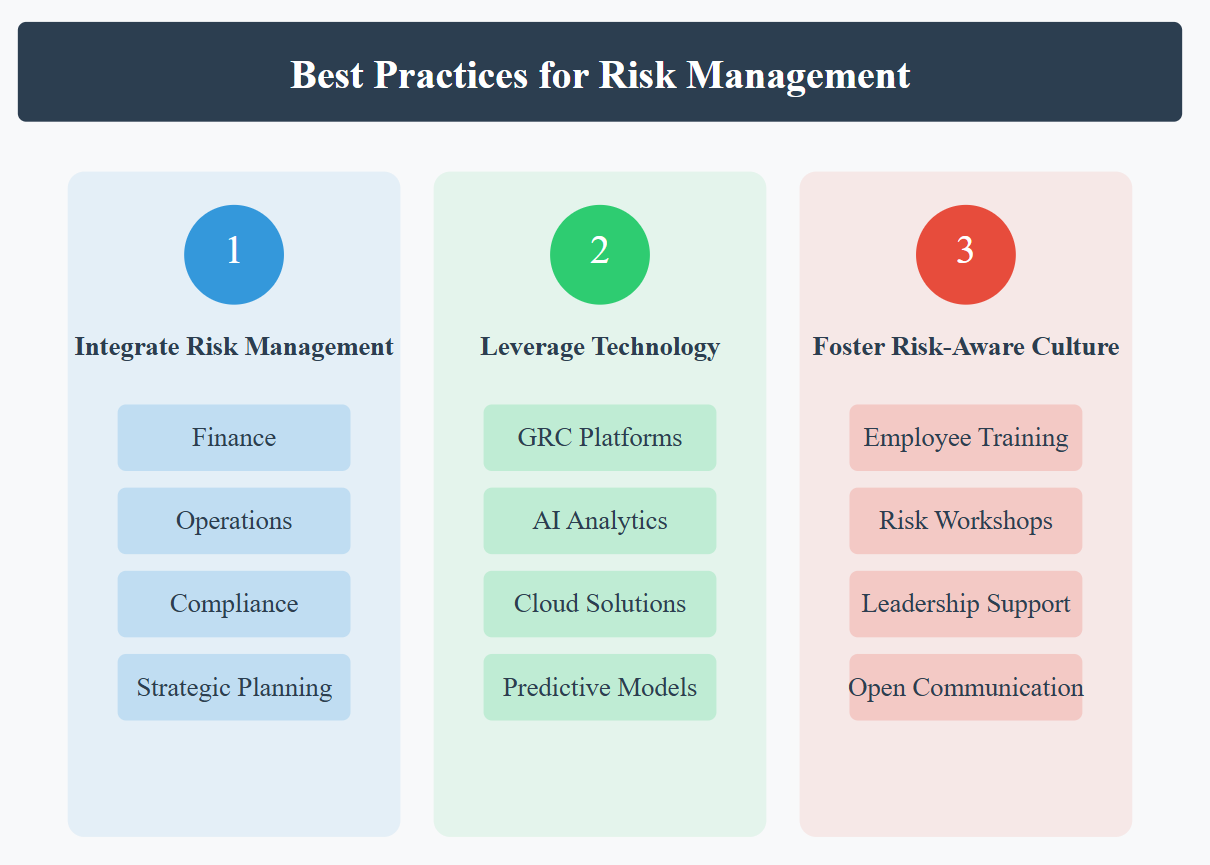
Part 2 – Risk Management for Executive Leaders: Proactive Strategies for Resilience and Growth


Challenges and Solutions in Risk Management
Effective risk management requires not only identifying and mitigating known threats but also anticipating emerging risks and balancing risk with strategic growth. As financial markets and operational landscapes become increasingly complex, executives must navigate several key challenges while implementing solutions that enhance organizational resilience and agility. The following are critical challenges in risk management and strategies to address them:

- Identifying Emerging Risks
In today’s rapidly evolving business environment, new risks—ranging from cyber threats and regulatory shifts to supply chain vulnerabilities— can emerge unexpectedly. Relying solely on historical data is no longer sufficient; organizations must proactively leverage predictive analytics, industry benchmarking, and AI-driven risk detection tools to identify potential threats before they materialize. By continuously monitoring economic indicators, market trends, and geopolitical developments, executives can ensure that their risk management strategies remain dynamic and forward-looking. - Balancing Risk and Growth
A common challenge for business leaders is determining how to manage risk without stifling innovation and growth. Fostering a culture of calculated risk-taking allows organizations to integrate risk assessments into strategic decision-making rather than viewing risk management as a constraint. Executives can achieve this balance by embedding risk analysis into investment evaluations, expansion plans, and product development strategies. Utilizing scenario planning and stress testing helps assess potential downsides while uncovering opportunities for sustainable growth. - Managing Data Overload
The digital age has brought an overwhelming influx of data, making it challenging to extract meaningful insights and prioritize risks effectively. Without the right tools, organizations risk drowning in information rather than leveraging it for proactive decision-making. Implementing risk management platforms, AI-powered analytics, and automation tools can help executives filter and categorize data, ensuring that only the most relevant and actionable insights drive strategic responses. Additionally, establishing key risk indicators (KRIs) ensures that leadership focuses on the most pressing risks rather than getting lost in irrelevant data points.
By addressing these challenges through advanced analytics, strategic integration, and technology-driven solutions, executives can transform risk management from a reactive function into a proactive driver of stability and growth.
Best Practices for Risk Management

- Integrate Risk Management Across Functions
Risk management cannot operate in isolation; it must be embedded across all key business functions, including finance, operations, compliance, and strategic planning. By fostering cross-functional collaboration, organizations can ensure that risks are identified and mitigated at every level. For instance, financial teams can assess liquidity risks, operations can evaluate supply chain vulnerabilities, and compliance teams can monitor regulatory changes. Establishing a centralized risk governance framework helps align these efforts, ensuring consistency and accountability throughout the organization. - Leverage Technology for Enhanced Risk Oversight
The rise of digital transformation has made it easier for businesses to monitor and mitigate risks in real time. Implementing Governance, Risk, and Compliance (GRC) platforms enables organizations to streamline risk tracking, automate reporting, and improve decision-making accuracy. AI-driven analytics, predictive modeling, and cloud-based risk management solutions allow executives to detect vulnerabilities before they escalate, ensuring a proactive approach to risk mitigation. By integrating technology into risk frameworks, organizations can enhance agility, efficiency, and regulatory compliance. - Foster a Risk-Aware Culture
Risk management is most effective when it is ingrained in an organization’s culture. Empowering employees at all levels with the knowledge and tools to identify and manage risks ensures a proactive rather than reactive approach. This involves regular training, risk-awareness workshops, and leadership engagement to reinforce the importance of risk management in daily operations. Encouraging open communication and feedback loops between departments also allows potential risks to be flagged early, minimizing financial and operational disruptions. Organizations with strong risk cultures are better positioned to adapt to challenges and seize growth opportunities with confidence.
Real-World Applications of Risk Management in Finance
1. Scenario Planning at Unilever
Unilever employs scenario planning to address the impact of rising raw material prices on its global supply chain. By modeling best-case, worst-case, and base-case scenarios, the company evaluates potential cost fluctuations and develops procurement strategies that ensure operational agility. For instance, Unilever adjusts sourcing locations and supplier contracts to mitigate risks from commodity price surges, maintaining consistent product pricing for consumers and protecting profit margins.
For more detailed information on Unilever’s scenario planning and risk management practices, you can refer to their Climate Transition Action Plan, which outlines their strategies for addressing climate-related risks and ensuring supply chain resilience (Look PDF)
2. Real-Time Monitoring at Amazon
Amazon leverages predictive analytics and real-time monitoring to proactively manage supply chain risks, especially during peak sales seasons like Black Friday and Prime Day. Advanced algorithms track variables such as shipping delays, inventory levels, and supplier performance, enabling Amazon to respond dynamically to disruptions. These insights allow the company to reroute shipments, optimize inventory allocation, and ensure on-time deliveries, maintaining customer satisfaction and operational efficiency under high demand.
Amazon utilizes predictive analytics and real-time monitoring to proactively address potential disruptions, especially during peak sales periods like Black Friday and Prime Day. Advanced algorithms track variables such as shipping delays, inventory levels, and supplier performance, enabling Amazon to respond dynamically to issues. These insights allow the company to reroute shipments, optimize inventory allocation, and ensure on-time deliveries, thereby maintaining customer satisfaction and operational efficiency under high demand.
For more detailed information on Amazon’s real-time supply chain monitoring and predictive analytics, you can refer to the following sources:
- AWS Supply Chain Management Solutions:This resource discusses how Amazon Web Services (AWS) offers purpose-built services that facilitate gathering and analyzing supply chain data from complex supply chains, utilizing technologies including data lakes and machine learning. (Look PDF)
- AWS Supply Chain Features:This page outlines how AWS Supply Chain unifies data and provides machine learning–powered actionable insights, built-in contextual collaboration, and demand planning, contributing to real-time monitoring and proactive supply chain management (Look PDF)
These resources provide comprehensive insights into Amazon’s application of predictive analytics and real-time monitoring in their supply chain operations.
These examples illustrate how organizations like Unilever and Amazon leverage risk management techniques to navigate complex challenges. Scenario planning empowers businesses to prepare for uncertainties and develop proactive strategies, while real-time monitoring ensures swift responses to emerging risks. By adopting such practices, companies can enhance operational resilience, safeguard profitability, and seize opportunities in an ever-evolving financial landscape.
Conclusion
Effective risk management is an indispensable pillar of resilient and forward-thinking leadership. It equips executives with the tools to navigate uncertainties, safeguard organizational stability, and drive sustainable growth. By mastering techniques such as risk identification, scenario planning, sensitivity analysis, and hedging, leaders can proactively mitigate vulnerabilities while unlocking opportunities in volatile markets.
Real-world applications, such as Unilever’s use of scenario planning to address raw material price fluctuations and Amazon’s real-time monitoring of supply chain risks, underscore the transformative power of robust risk management practices. These strategies not only protect profitability and operational efficiency but also enable organizations to respond dynamically to challenges and seize strategic opportunities.
By integrating advanced tools like predictive analytics, risk-adjusted discount rates, and stress testing, executives can create proactive and tailored risk management plans that align with their strategic objectives. This balance between risk and reward positions organizations to thrive in an ever-evolving business landscape, fostering resilience, agility, and long-term success.

Practical Application in Coaching
The Financial Management Empowerment Coaching Program by NB Global Consulting ensures that all concepts are applied to real-world scenarios. Each coaching session is customized to the participant’s organizational challenges, ensuring practical relevance.
Empower your organization with the tools and strategies to thrive in an ever-changing market. Join NB Global Consulting’s programs and transform your approach to financial leadership today.
Useful Pages
E-mail: info@nbglobalconsulting.com
2025, NB GLOBAL CONSULTING. All rights reserved. Made with ❤️ by ROSA eSolutions.


